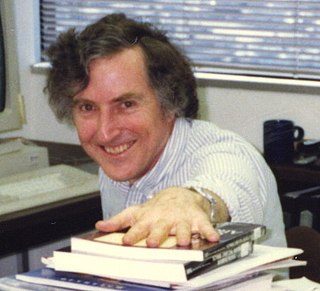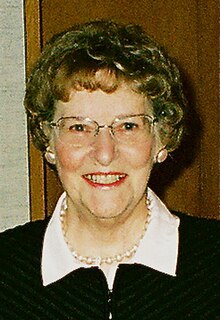The Domain Name System (DNS) is a hierarchical and distributed naming system for computers, services, and other resources in the Internet or other Internet Protocol (IP) networks. It associates various information with domain names assigned to each of the associated entities. Most prominently, it translates readily memorized domain names to the numerical IP addresses needed for locating and identifying computer services and devices with the underlying network protocols. The Domain Name System has been an essential component of the functionality of the Internet since 1985.

The history of the Internet has its origin in the efforts of scientists and engineers to build and interconnect computer networks. The Internet Protocol Suite, the set of rules used to communicate between networks and devices on the Internet, arose from research and development in the United States and involved international collaboration, particularly with researchers in the United Kingdom and France.
The Internet protocol suite, commonly known as TCP/IP, is a framework for organizing the set of communication protocols used in the Internet and similar computer networks according to functional criteria. The foundational protocols in the suite are the Transmission Control Protocol (TCP), the User Datagram Protocol (UDP), and the Internet Protocol (IP). Early versions of this networking model were known as the Department of Defense (DoD) model because the research and development were funded by the United States Department of Defense through DARPA.

Jonathan Bruce Postel was an American computer scientist who made many significant contributions to the development of the Internet, particularly with respect to standards. He is known principally for being the Editor of the Request for Comment (RFC) document series, for Simple Mail Transfer Protocol (SMTP), and for administering the Internet Assigned Numbers Authority (IANA) until his death.
A Request for Comments (RFC) is a publication in a series from the principal technical development and standards-setting bodies for the Internet, most prominently the Internet Engineering Task Force (IETF). An RFC is authored by individuals or groups of engineers and computer scientists in the form of a memorandum describing methods, behaviors, research, or innovations applicable to the working of the Internet and Internet-connected systems. It is submitted either for peer review or to convey new concepts, information, or, occasionally, engineering humor.

Stephen D. Crocker is an Internet pioneer. In 1969, he created the ARPA "Networking Working Group" and the Request for Comments series. He served as chair of the board of the Internet Corporation for Assigned Names and Numbers (ICANN) from 2011 through 2017.
A datagram is a basic transfer unit associated with a packet-switched network. Datagrams are typically structured in header and payload sections. Datagrams provide a connectionless communication service across a packet-switched network. The delivery, arrival time, and order of arrival of datagrams need not be guaranteed by the network.

Johns Frederick (Jeff) Rulifson is an American computer scientist.
InterNIC, known as the Network Information Center (NIC) until 1993, was the organization primarily responsible for Domain Name System (DNS) domain name allocations and X.500 directory services. From its inception in 1972 until October 1, 1991, it was run by the Stanford Research Institute, now known as SRI International, and led by Jake Feinler. From October 1991 until September 18, 1998, it was run by Network Solutions. Thereafter, the responsibility was assumed by the Internet Corporation for Assigned Names and Numbers (ICANN).

The Advanced Research Projects Agency Network (ARPANET) was the first wide-area packet-switched network with distributed control and one of the first computer networks to implement the TCP/IP protocol suite. Both technologies became the technical foundation of the Internet. The ARPANET was established by the Advanced Research Projects Agency (ARPA) of the United States Department of Defense.
The Network Control Protocol (NCP) was a communication protocol for a computer network in the 1970s and early 1980s. It provided the transport layer of the protocol stack running on host computers of the ARPANET, the predecessor to the modern Internet.
The domain name arpa is a top-level domain (TLD) in the Domain Name System (DNS) of the Internet. It is used predominantly for the management of technical network infrastructure. Prominent among such functions are the subdomains in-addr.arpa and ip6.arpa, which provide namespaces for reverse DNS lookup of IPv4 and IPv6 addresses, respectively.
SRI International's Augmentation Research Center (ARC) was founded in the 1960s by electrical engineer Douglas Engelbart to develop and experiment with new tools and techniques for collaboration and information processing.

Robert Braden was an American computer scientist who played a role in the development of the Internet. His research interests included end-to-end network protocols, especially in the transport and network layers.
WHOIS is a query and response protocol that is used for querying databases that store an Internet resource's registered users or assignees. These resources include domain names, IP address blocks and autonomous systems, but it is also used for a wider range of other information. The protocol stores and delivers database content in a human-readable format. The current iteration of the WHOIS protocol was drafted by the Internet Society, and is documented in RFC 3912.
In computer networking, a port or port number is a number assigned to uniquely identify a connection endpoint and to direct data to a specific service. At the software level, within an operating system, a port is a logical construct that identifies a specific process or a type of network service. A port at the software level is identified for each transport protocol and address combination by the port number assigned to it. The most common transport protocols that use port numbers are the Transmission Control Protocol (TCP) and the User Datagram Protocol (UDP); those port numbers are 16-bit unsigned numbers.
The internet layer is a group of internetworking methods, protocols, and specifications in the Internet protocol suite that are used to transport network packets from the originating host across network boundaries; if necessary, to the destination host specified by an IP address. The internet layer derives its name from its function facilitating internetworking, which is the concept of connecting multiple networks with each other through gateways.






